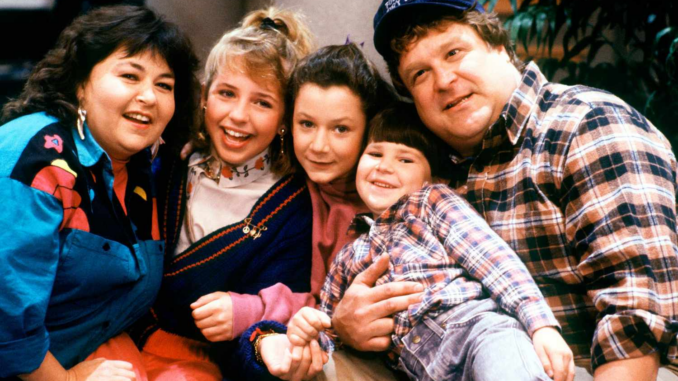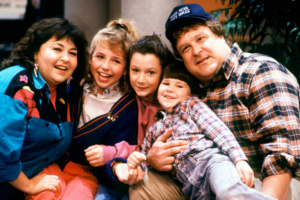
Introduction: A Revolution in American Television
In the world of television sitcoms, it’s rare for a show to not only captivate audiences but also become a defining cultural moment. Roseanne, which premiered in 1988, did just that. Centered around the Conner family—an unapologetically imperfect, working-class family living in the fictional town of Lanford, Illinois—Roseanne quickly captured the hearts of millions. More than just a comedy about a mom, dad, and their kids, the show revolutionized how American families were portrayed on TV.
For years, primetime television had been dominated by idealized families like The Cosby Show’s Huxtables and Full House’s Tanner family. The Conners, however, were different. With its raw portrayal of middle-class struggles—balancing bills, jobs, and personal life—the show resonated deeply with a broad audience. The relatability of Roseanne Conner, played by the indomitable Roseanne Barr, set Roseanne apart from its contemporaries, opening doors for future sitcoms to explore more nuanced, complex family dynamics.
The Unfiltered Reality of Working-Class America
What made Roseanne truly groundbreaking was its unapologetic portrayal of the working class. While most sitcoms at the time focused on upper-middle-class or idealized families, Roseanne grounded itself in the reality of everyday life for families struggling to make ends meet. The show didn’t shy away from discussing financial stress, underpaid jobs, and the overwhelming responsibilities of raising children.
The Conner family, led by the witty and sharp-tongued Roseanne, was not wealthy. In fact, the family lived paycheck to paycheck, often struggling to balance their bills. Yet, it was precisely this financial struggle that made Roseanne so relatable. It didn’t shy away from the complexities of adult life, and it depicted working-class Americans in a way that hadn’t been seen on television before.
In one memorable episode, the Conners face the looming threat of losing their house. Instead of the stereotypical “feel-good” resolution, the family comes together to face the real challenge of overcoming their financial woes. It was a stark contrast to the many sanitized portrayals of perfect families, where issues like poverty and job insecurity were rarely addressed.
Character Development and Relatability: A Family Like No Other
What truly made Roseanne special, however, was its characters. Unlike many sitcoms where family members often felt like exaggerated versions of a stereotype, the Conners felt real, imperfect, and deeply relatable. The dynamic between Roseanne and her husband Dan (played by John Goodman) was that of a married couple who, despite their differences, deeply cared for each other. Their relationship wasn’t perfect, but it was filled with love, humor, and an understanding of the struggles they faced.
Roseanne herself was unlike any other matriarch on television. She wasn’t the idealized, self-sacrificing mother that many sitcoms portrayed. Instead, Roseanne was funny, loud, opinionated, and unapologetically real. She wasn’t afraid to call out her kids when they misbehaved or make snarky remarks at her husband. But beneath her tough exterior was a mother who would do anything to protect her family. Roseanne wasn’t just a sitcom mom—she was a reflection of the millions of real, working mothers across the country.
Dan Conner, Roseanne’s husband, was another groundbreaking character. As the blue-collar dad who worked construction and wasn’t always the most refined, Dan was an honest portrayal of the working-class father. He didn’t have the clean-cut charm of sitcom dads like Family Ties’s Steven Keaton or The Cosby Show’s Cliff Huxtable. Yet, Dan’s authenticity and love for his family made him one of the most beloved characters on the show.
The supporting cast, too, contributed to the show’s enduring success. Jackie, Roseanne’s sister, played by Laurie Metcalf, was an eccentric and fiercely loyal character who added depth to the show. The show also introduced us to Becky, Darlene, and DJ—the Conner children—whose personal growth and struggles with identity, love, and independence were explored with remarkable depth for a sitcom.
The Humor and Social Commentary: Balancing Comedy with Real Life
While Roseanne undoubtedly had its moments of laughter, what made the show stand out was its ability to tackle serious, often taboo subjects while still maintaining its comedic edge. From abortion and teen pregnancy to addiction and mental health, Roseanne was one of the first sitcoms to address these weighty issues head-on. And it did so in a way that wasn’t preachy or overly sentimental.
One of the most iconic episodes in the show’s history is when Roseanne gets an abortion after realizing she is pregnant at an inopportune time. The episode, titled “Don’t Ask Me Why,” aired in 1991 and was groundbreaking for its honest and unsentimental portrayal of abortion. It didn’t treat the decision as a moral issue; instead, it simply showed a woman dealing with a tough personal choice—a rarity in television at the time.
Another powerful example of the show’s social commentary was its approach to LGBTQ+ issues. In a famous episode, Roseanne’s sister Jackie’s partner, Nancy, comes out as gay. This was one of the first instances of LGBTQ+ representation on mainstream TV, and it was done with humor, sensitivity, and respect.
These examples show that Roseanne wasn’t afraid to push boundaries and confront difficult societal issues while still being, at its core, a sitcom. It made its audience laugh, but it also made them think.

Conclusion: A Legacy That Lives On
Roseanne changed the landscape of American television forever. It pushed boundaries, gave a voice to the working class, and provided audiences with a depiction of family that was both funny and brutally honest. The show’s cultural impact can still be felt today, as it set the stage for later shows that would follow in its footsteps, like The Middle and Superstore.
While the series’ run may have ended in 1997, and despite the controversies that surrounded the reboot in 2018, Roseanne’s influence endures. It showed audiences that families don’t have to be perfect to be real, and that laughter could be found even in the hardest of times.
As we look back at Roseanne, it’s clear that the show wasn’t just another sitcom—it was a landmark in TV history, one that will continue to shape how we see ourselves, our families, and our society.
